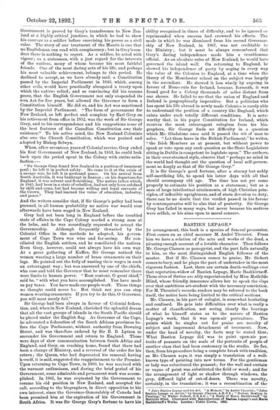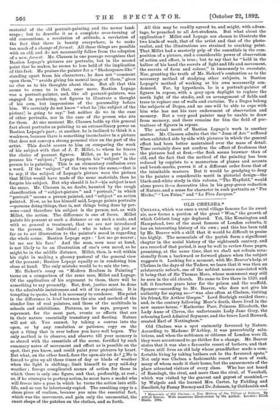BASTIEN LEPAGE.*
IN arrangement, this book is a species of funeral procession. First comes on as chief mourner M. Andre Theuriet. From him we have a relation of the acts and works of the dead, a pleasing enough account of a lovable character. Then follows Mr. George Clausen as panegyrist, and the part falls naturally to him, as the most distinguished English follower of the master. But if Mr. Clausen comes to praise, Mr. Sickert comes to bury, and he plays the part of undertaker in the most vigorous fashion. Last, there are certain death-wailings over that reputation-widow of Bastien Lepage, Marie Bashkirtseff. These rites of Suttee are ably superintended by Miss Mathilde Blind, whose friendly innocence allows her to speak the doge over that ambitions art-student with the necessary conviction. For M. Thenriet's records, readers may be referred to the book itself, the notice here being limited to the critical sections.
Mr. Clausen, in his part of eulogist, is somewhat hesitating and confused. He gets into difficulties over what in really a matter of classification, not seeing clearly the bearings of what he himself states as to the nature of Bastien Lepage's work, that it was open-air portraiture. The points which he singles out for praise are novelty of subject and impersonal detachment of treatment. Now, under the head of novelty, the facts may be stated thus. What Bastien Lepage did was to paint open-air por- traits of peasants on the scale of the portraits of people of another class that had been customary in the studio. So far, then, from his procedure being a complete break with tradition, as Mr. Clausen says, it was simply a translation of a well- known type of painting into new terms. For the gentleman or lady was substituted the peasant; for the wall and curtain or vague of paint was substituted the field or wood ; and for the arrangement of light or shadow through windows, the grey, diffused light of out-of-doors. There was novelty, certainly, in the translation ; it was a recombination of the * Jules Bastian Lepage and his Art. "A Memoir." by A.ndr6 Theariet ; "Jules Bastion Lepage as Artist," by George Clausen, A.R.N I. "Modern Realism in Painting," by Walter Siefert, ; "A Study of Marie Bashk-irtseffiLIrt Itiathilde Blind. Illustrated with Reproductions of Bastion Lepage's and Bashkirtseff's Works. London; Fisher Unwin. 1892. material of the old portrait-painting and the newer land- scape; but to describe it as a complete over-turning of old conventions, a revolution of attitude, a revelation of the fact that there is beauty everywhere, is to make too much of a change of format. All these things are possible with an old, and do not necessarily follow from the adoption of a new, format. Mr. Clausen in one passage recognises that Bastien Lepage's pictures are portraits, but in the second point that he makes, he seems to lose hold of the implication of this fact. He praises the painter for a " Shakespeare-like " standing apart from his characters; he does not "comment upon them," "avoids giving his mental image of them," gives no clue as to his thoughts about them. But all that this seems to come to is that, once more, Bastien Lepage was a portrait-painter, and, like all portrait-painters, was engaged in producing, not figures to illustrate a thought of his own, but impressions of the personality before him. We certainly do not know "what he [the subject of the picture] is going to say," but neither do we in the case of other portraits, nor in the case of the person who sits for them. At one moment Mr. Clausen holds up this general fact about portraits as pointing to an extraordinary power on Bastien Lepage's part; at another, he is inclined to think it a weakness, because there is something inconclusive in a picture that does not convey a strong personal view on the part of the artist. This doubt occurs to him on comparing the work of his subject with that of J. F. Millet, to whom he traces the choice of peasant figures. Millet, as he puts it, ex- presses his "subject;" Lepage forgets his " subject " in the person he is painting. This is an elementary confusion over a word. If the " subject " of the two were the same,—that is to say, if the subject of Lepage's picture were the picture that Millet would have made of the same materials, then he forgets his subject. But why should it be ?—his subject is not the same. Mr. Clausen is, no doubt, haunted by the rough classification of " subject-picture " and "portrait," in which "portrait" means a person painted, and " subject " an action painted. Now, as he has himself said, Lepage paints portraits —persons doing things, that is, not things being done by per. eons—and therefore his subject is the person, not, as with Millet, the action. The difference is one of focus. Millet paints his peasant at such a distance or on such a scale, and with so general a treatment, that ' we are not introduced to the person, the individual ; who is taken up just so far as to act illustration to the painter's mood in regarding the whole scene. Bastien Lepage says : 'Let me go nearer ; let me see his face.' And the man, seen near at hand, is not likely to be an illustration of one's own mood, as he might be in the middle distance. Millet, then, is well within his right in making a gloomy pastoral of the general view of the peasant; Bastien Lepage equally so in rendering him close at hand. The only mistake would be to mix the two.
Mr. Sickert's essay on "Modern Realism in Painting" turns on a comparison of the same men, Millet and Lepage. Of the application of his argument to them, there will be something to say presently. Bat, first, justice must be done to the admirable incisiveness and wit of its exposition. It is tempting to quote, but it is necessary to condense. His point is the difference in kind between the aim and method of the slender line of real painters, and those of the multitude in schools and exhibitions. Pictures, as he says, purport to represent, for the most part, events or effects that are in their nature essentially transitory and fleeting. Nature will not sit. You cannot, by taking a canvas into the open, or by any resolution or patience, copy on the spot a thing that is over before you have well begun. The only method is to observe, and observe till your memory is so stored with the essentials of the scene, fortified by such summary notes of movement and effect as is possible on the spot, that you know, and could paint your pictures by heart. But what, on the other hand, does the open-air-ist do ?.1 He is forced to give up all those times of day or kinds of weather when the light is shifting; limit himself to grey mid-day weather ; forego complicated scenes of action for those in which there is only one figure, and that, preferably, at rest; or, if he attempts to portray action, he must have a model who will freeze into a pose in which he turns the action into still- life, and so can be laboriously copied. The resulting copy is a sham piece of realism, because you miss the essential fact, which was the movement, and gain only the unessential, the exact shape of the patches on the clothes, and so forth.
All this may be readily agreed to, and might, with advan- tage, be preached to all Art-students. But what about the application ? Millet and Lepage are chosen to illustrate the two kinds of work, that of the artist and that of the photo. realist, and the illustrations are strained to cracking point. That Millet had a masterly grip of the essentials in the com- position of a picture, and a considerable power of observation of action and effect, is true; but to say that he "held in the hollow of his hand the secrets of light and life and movement, the secrets of form and colour," is immensely to overstate. Nor, granting the truth of Mr. Sickert's contention as to the necessary method of studying other subjects, is Bastien Lepage's method of working at his own necessarily con- demned. For, by hypothesis, he is a portrait-painter of figures in repose, with a grey open daylight to replace the north light of the studio, and an arrangement of fields and trees to replace one of walls and curtains. To a Degas belong the subjects of Degas, and no one will be able to cope with him who has not his rare endowment of observation and memory. But a very good painter may be unable to draw from memory, and there remains for him the field of por- traiture of figures in repose.
The actual merit of Bastien. Lepage's work is another matter. Mr. Clausen admits that the "Joan of Arc" suffered when exhibited side by side with pictures in which the general effect had been better maintained over the mass of detail. Time certainly does not confirm the effect of freshness that the pictures had at first,—the flesh seems browner than of old, and the fact that the method of the painting has been reduced by copyists to a mannerism of planes and accents and brush-marks, proves it of a different order from that of the inimitable masters. Bat it would be grudging to deny to the painter a considerable merit in pictorial design—the black-and-white study in this volume, "The Hayfield," would alone prove it—a decorative idea in his grey-green redaction of Nature, and a sense for character in such portraits as "Pas Meche," "Lea Foins," and "Le Pere Jacques."







































 Previous page
Previous page